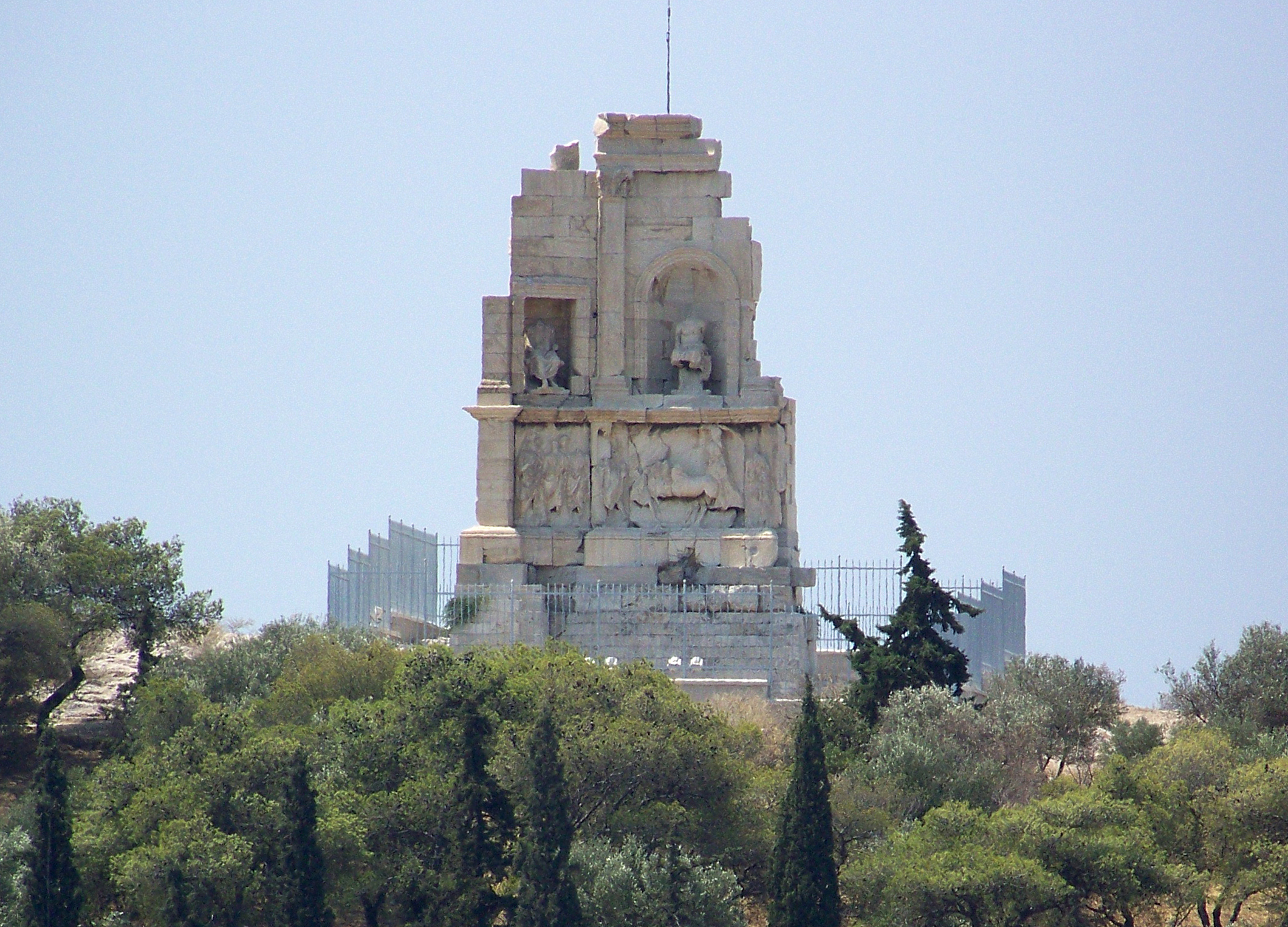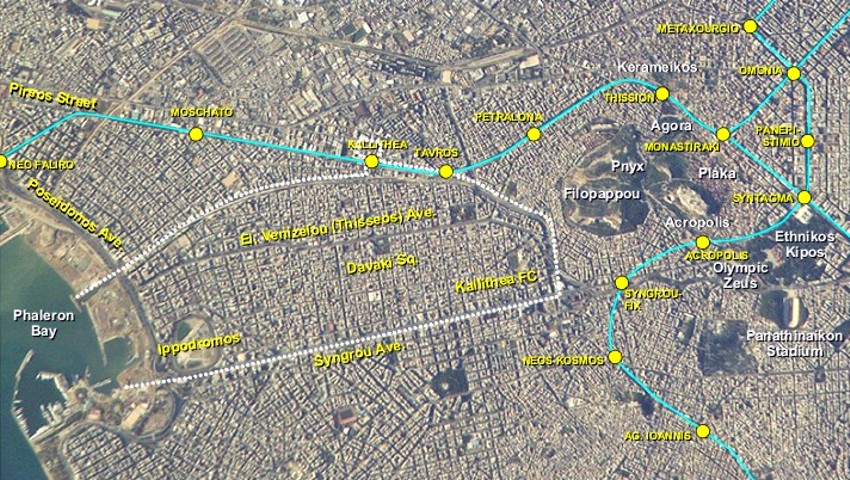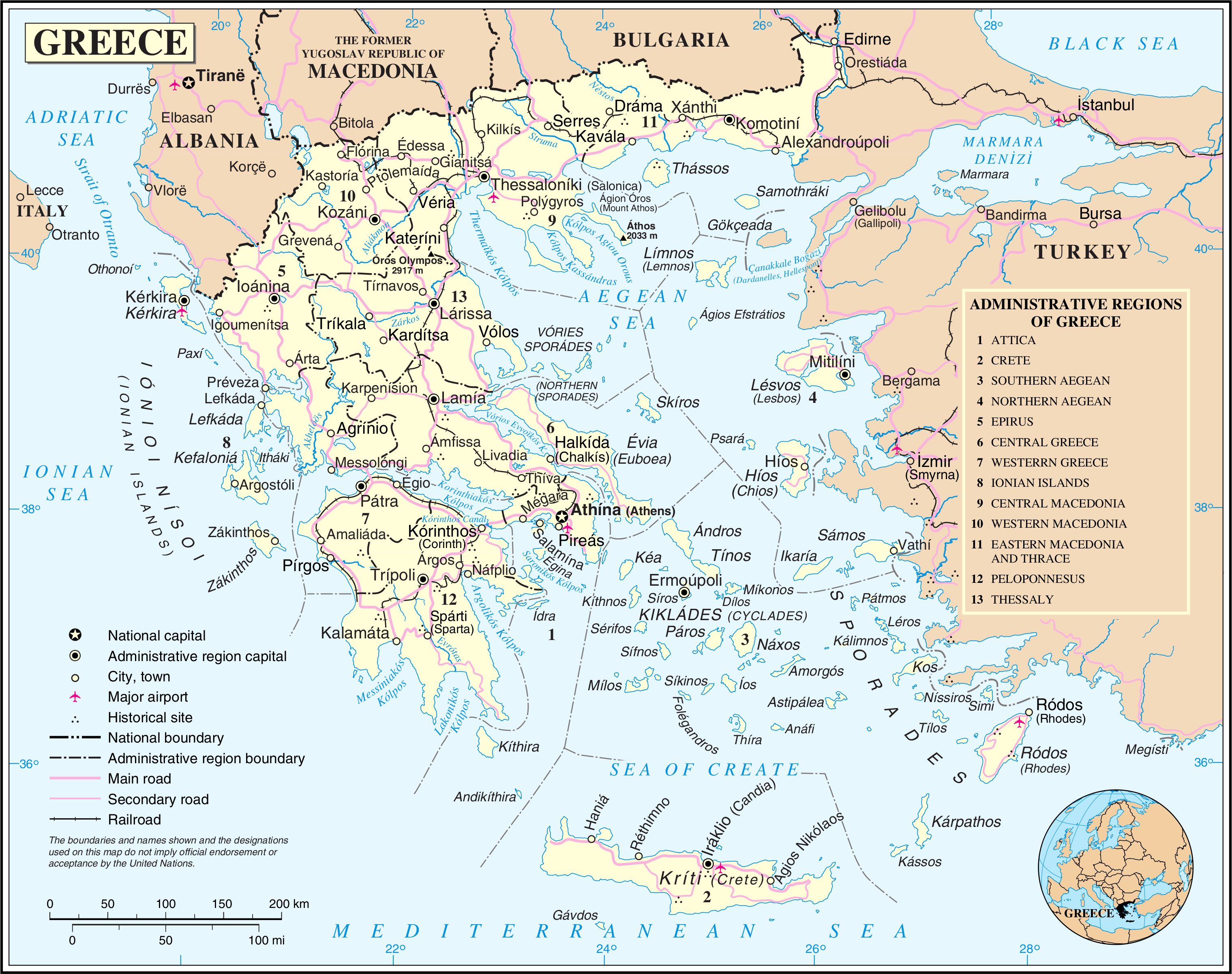|
Filopappou
Philopappou or Filopappou ( el, Φιλοπάππου ) is a small neighborhood of Athens, Greece south of the Philopappos Monument, from which it takes its name. Philopappou Hill Filopappou Hill or Mouson Hill or Seggio Hill is a hill in Athens located opposite, southwest, from the Acropolis. It is connected to the adjacent hills of Asteroskopeio (hill of Nymphs) and Pnyka. At its top there is the monument of Philopappos which was erected by His Highness Philopappos during the Roman occupation and gave his name to the hill. Around the hill of Filopappou is the district of the same name as well as the districts of Koukaki, Asyrmatos, Petralona and Acropolis. On the south side of the hill there is also the Dora Stratou theater. The oldest name "Segio hill" dates back to the time of the Frankish occupation and was preserved until the beginning of the last century. The etymology of this name apparently comes from the Italian word segno, (segno = signal, signal), perhaps because du ... [...More Info...] [...Related Items...] OR: [Wikipedia] [Google] [Baidu] |
Athens
Athens ( ; el, Αθήνα, Athína ; grc, Ἀθῆναι, Athênai (pl.) ) is both the capital city, capital and List of cities and towns in Greece, largest city of Greece. With a population close to four million, it is also the seventh List of urban areas in the European Union, largest city in the European Union. Athens dominates and is the capital of the Attica (region), Attica region and is one of the List of oldest continuously inhabited cities, world's oldest cities, with its recorded history spanning over 3,400 years and its earliest human presence beginning somewhere between the 11th and 7th millennia BC. Classical Athens was a powerful Greek city-state, city-state. It was a centre for the arts, learning and philosophy, and the home of Plato's Platonic Academy, Academy and Aristotle's Lyceum (classical), Lyceum. It is widely referred to as the cradle of civilization, cradle of Western culture, Western civilization and the democracy#History, birthplace of democracy, larg ... [...More Info...] [...Related Items...] OR: [Wikipedia] [Google] [Baidu] |
Koukaki
Koukaki ( el, Κουκάκι or , ) is a southeast neighbourhood of the Municipality of Athens, Greece. Location The general area of Koukaki borders from the north with Makrygianni neighbourhood and the historical district of Plaka (the historical neighbourhood of Athens), the Municipality of Kallithea and Petralona neighbourhood from the south, Neos Kosmos neighbourhood from the east, and Filopappou and Thisio neighbourhoods from the west. The two largest streets that cross Koukaki are Veikou Street (north-to-south) and Dimitrakopoulou Street (south-to-north). On the borderline between Koukaki and Neos Kosmos stands Andrea Syngrou Avenue, an important avenue in Athens that connects its center with Poseidonos Avenue to the south. Amenities It has a large weekly vegetable market every Friday. Transportation Koukaki is served by two Athens Metro stations, '' Akropoli'' (near the Acropolis) and '' Syngrou Fix'' (on Andrea Syngrou Avenue). The nearest overground station is Petr ... [...More Info...] [...Related Items...] OR: [Wikipedia] [Google] [Baidu] |
Kallithea
Kallithea (Greek: Καλλιθέα, meaning "beautiful view") is a district of Athens and a municipality in south Athens regional unit. It is the eighth largest municipality in Greece (96,118 inhabitants, 2021 census) and the fourth biggest in the Athens urban area (following municipalities of Athens, Piraeus and Peristeri). Additionally, it is the 2nd most densely populated municipality in Greece and one of the most densely populated cities in the world, with . The municipality has an area of . Location The center of Kallithea (Davaki Square) lies at a distance of to the south of the Athens city center (Syntagma Square) and to the north-east of the Piraeus (photo 1). Kallithea extends from the Filopappou and Sikelia hills in the north to Phaleron Bay in the south; its two other sides consist of Syngrou Avenue to the east (border to the towns of Nea Smyrni and Palaio Faliro), and the Ilisos River to the west (border to the towns of Tavros and Moschato) (photo 2). T ... [...More Info...] [...Related Items...] OR: [Wikipedia] [Google] [Baidu] |
Attica
Attica ( el, Αττική, Ancient Greek ''Attikḗ'' or , or ), or the Attic Peninsula, is a historical region that encompasses the city of Athens, the capital of Greece and its countryside. It is a peninsula projecting into the Aegean Sea, bordering on Boeotia to the north and Megaris to the west. The southern tip of the peninsula, known as Laurion, was an important mining region. The history of Attica is tightly linked with that of Athens, and specifically the Golden Age of Athens during the classical period. Ancient Attica ( Athens city-state) was divided into demoi or municipalities from the reform of Cleisthenes in 508/7 BC, grouped into three zones: urban (''astu'') in the region of Athens main city and Piraeus (port of Athens), coastal (''paralia'') along the coastline and inland ('' mesogeia'') in the interior. The modern administrative region of Attica is more extensive than the historical region and includes Megaris as part of the regional unit West Att ... [...More Info...] [...Related Items...] OR: [Wikipedia] [Google] [Baidu] |
Modern Regions Of Greece
The regions of Greece ( el, περιφέρειες, translit=periféries) are the country's thirteen first-level administrative entities, each comprising several second-level units, originally known as prefectures and, since 2011, as regional units. History The current regions were established in July 1986 (the presidential decree officially establishing them was signed in 1987), by decision of the interior minister, Menios Koutsogiorgas, as second-level administrative entities, complementing the prefectures (Law 1622/1986). Ν.1622/86 "Τοπική Αυτοδιοίκηση - Περιφερειακή Ανάπτυξη - Δημοκρατικός Προγραμματισμός", (ΦΕΚ 92/τ.Α΄/14-7-1986) Before 1986, there was a traditional division into broad historical–geographical regions (γεωγραφικά διαμερίσματα), which, however, was often arbitrary; not all of the pre-1986 traditional historical-geographic regions had official administrative bod ... [...More Info...] [...Related Items...] OR: [Wikipedia] [Google] [Baidu] |
Neighborhood
A neighbourhood (British English, Irish English, Australian English and Canadian English) or neighborhood (American English; see spelling differences) is a geographically localised community within a larger city, town, suburb or rural area, sometimes consisting of a single street and the buildings lining it. Neighbourhoods are often social communities with considerable face-to-face interaction among members. Researchers have not agreed on an exact definition, but the following may serve as a starting point: "Neighbourhood is generally defined spatially as a specific geographic area and functionally as a set of social networks. Neighbourhoods, then, are the spatial units in which face-to-face social interactions occur—the personal settings and situations where residents seek to realise common values, socialise youth, and maintain effective social control." Preindustrial cities In the words of the urban scholar Lewis Mumford, "Neighbourhoods, in some annoying, inchoate f ... [...More Info...] [...Related Items...] OR: [Wikipedia] [Google] [Baidu] |
Philopappos Monument
The Philopappos Monument ( el, Μνημείο Φιλοπάππου, , ) is an ancient Greek mausoleum and monument dedicated to ''Gaius Julius Antiochus Epiphanes Philopappos'' or ''Philopappus'', ( el, Γάιος Ιούλιος Αντίοχος Επιφανής Φιλόπαππος, 65–116 AD), a prince from the Kingdom of Commagene. It is located on Mouseion Hill in Athens, Greece, southwest of the Acropolis. Origins Philopappos died in 116, and his death caused great grief to his sister Julia Balbilla, citizens of Athens and possibly to the imperial family. As a dedication to honor the memory of Philopappos, Balbilla with the citizens of Athens erected a tomb structure on Muses Hill () near the Acropolis of Athens. His marble tomb monument is still known as the Philopappos (or Philopappou) Monument, and the hill is today known as Philopappou Hill (). The Greek geographer Pausanias describes Philopappos’ grand tomb as a ''monument built for a Syrian man''. The monument ... [...More Info...] [...Related Items...] OR: [Wikipedia] [Google] [Baidu] |
Petralona Station
Petralona ( el, Πετράλωνα) is a metro Line 1 station, located in Petralona 7.016 km from Piraeus station. It is located in Athens and took its name from the neighbourhood in Athens Athens ( ; el, Αθήνα, Athína ; grc, Ἀθῆναι, Athênai (pl.) ) is both the capital city, capital and List of cities and towns in Greece, largest city of Greece. With a population close to four million, it is also the seventh List ..., It was first opened on 22 November 1954 and features two platforms. It was renovated in 2004. References Athens Metro stations Railway stations opened in 1954 1954 establishments in Greece {{Athens-struct-stub ... [...More Info...] [...Related Items...] OR: [Wikipedia] [Google] [Baidu] |
Line 1 (Athens Metro)
Line 1 is the oldest of the three lines of the Athens Metro, running from to . The Athens-Piraeus Railway Company (SAP S.A.) first opened the line, between and , on 27 February 1869. On 4 February 1885 Lavrion Square-Strofyli railway line opened between Attiki Square and . These railway lines gradually merged and converted to a rapid-transit system. It was merged into the Athens Metro network upon the opening of Lines 2 and 3 on 28 January 2000. Network Line 1 connects the port of Piraeus with the northern suburb of Kifissia. It is built to and is electrified using the 750 V DC, third rail, top contact system, also used by Lines 2 and 3. From Piraeus the line runs eastwards to Faliro and then north to Moschato, Kallithea, Tavros, Petralona, Thissio, Monastiraki, Omonia, Victoria and Attiki. Between Monastiraki and Attiki the line runs underground. At Monastiraki passengers can change to Line 3 and at Omonia and Attiki to Line 2. From Attiki the line continues north, ... [...More Info...] [...Related Items...] OR: [Wikipedia] [Google] [Baidu] |
Greece
Greece,, or , romanized: ', officially the Hellenic Republic, is a country in Southeast Europe. It is situated on the southern tip of the Balkans, and is located at the crossroads of Europe, Asia, and Africa. Greece shares land borders with Albania to the northwest, North Macedonia and Bulgaria to the north, and Turkey to the northeast. The Aegean Sea lies to the east of the mainland, the Ionian Sea to the west, and the Sea of Crete and the Mediterranean Sea to the south. Greece has the longest coastline on the Mediterranean Basin, featuring thousands of islands. The country consists of nine traditional geographic regions, and has a population of approximately 10.4 million. Athens is the nation's capital and largest city, followed by Thessaloniki and Patras. Greece is considered the cradle of Western civilization, being the birthplace of democracy, Western philosophy, Western literature, historiography, political science, major scientific and mathematical p ... [...More Info...] [...Related Items...] OR: [Wikipedia] [Google] [Baidu] |
Line 2 (Athens Metro)
Line 2 of the Athens Metro runs entirely underground from in the northwest to in the south, via . It first opened, between and , on 28 January 2000, with Line 3. On 6 April 2013, Line 2 was extended to Anthoupoli in the north west, and on 26 July 2013 to Elliniko to the south. Future extensions According to the Athens Metro Development Plan of September 2022, Attiko Metro (who develops and builds Metro extensions) is exploring extensions to both ends of Line 2. Both extensions first appeared in the Souflias plan in April 2009, which envisaged the extension of Line 2 to in the north, and Glyfada in the south. Northern extension The first phase of the northern extension may consist of a line from to Agios Nikolaos, with intermediate stations at Palatiani and Ilion (for Line 4): a potential second phase may consist of a line from Agios Nikolaos to Acharnes, with intermediate stations at Kamatero and (for Athens Suburban Railway trains). Southern extension The s ... [...More Info...] [...Related Items...] OR: [Wikipedia] [Google] [Baidu] |
Athens Metro
The Athens Metro ( el, Μετρό Αθήνας, Metro Athinas, translit-std=iso) is a rapid-transit system in Greece which serves the Athens urban area and parts of East Attica. Line 1 opened as a conventional steam railway in 1869 and electrified in 1904. In 1991, Attiko Metro S.A. constructed and extended Lines 2 and 3. It has significantly changed Athens by providing a much-needed solution to the city's traffic and air pollution problem, as well as revitalising many of the areas it serves. Extensions of existing lines are under development, as well as a new Line 4, whose central section began construction in October 2021. The Athens Metro is actively connected with the other means of public transport, such as buses, trolleys, the Athens Tram and the Athens Suburban Railway. The Athens Metro is hailed for its modernity (mainly the newer lines 2, 3) and many of its stations feature works of art, exhibitions and displays of the archaeological remains found during its constru ... [...More Info...] [...Related Items...] OR: [Wikipedia] [Google] [Baidu] |





.png)
.jpg)
